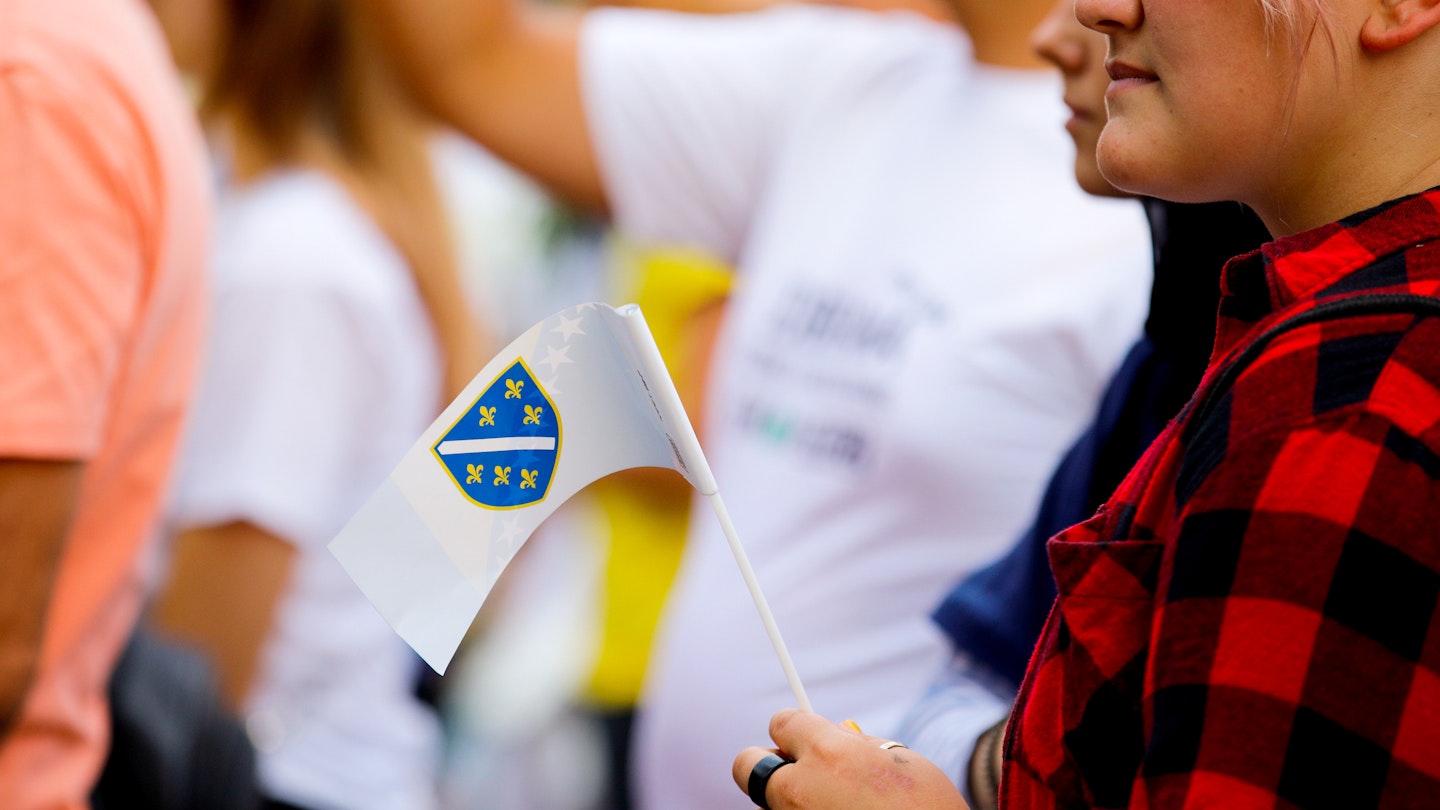Discover Sarajevo’s History with Almir’s Guided Tour
“How do you like my artwork?” says Almir Ahmetagic, a wry smile creeping across his face as he points to a large dent in the minivan we have just clambered out of. He shrugs and lets out a small laugh, his car keys jangling in his hand.
This playful comment instantly breaks the ice among our intimate three-person tour group. Thirty years on from the end of the Bosnian War, we have just been taken to one of the many places where bullet holes still pepper Sarajevo’s residential buildings.
Learning about one of the most brutal and longest sieges in modern history can be heavy, but with Almir around, we can expect a few dark-humored jokes along the way.
His experience of surviving the war is harrowing. He was shot twice and had to watch as enemy forces burned down his home, not long before his own brother tragically died from sniper fire. However, despite all this, his story — and that of the city — is leavened with hope.
Almir’s Hope-Filled Tour of Bosnia’s Difficult Past
Almir was about 15 when the siege of Sarajevo began in 1992. He joined the army that year with his brother to fight against the Serbian forces that had besieged the capital city. Witnessing firsthand many pivotal moments from the near-four-year-long siege, Almir provides guided tours of his hometown for visitors who want to better understand Bosnia and Hercegovina’s difficult but fascinating past.
“I was thinking, ‘I’m going to impress all these girls,’” he jokes, recalling why he joined the army. “But, really, the Serb army left us only one option: to fight. Because in every town that was taken, civilians were killed.” It’s estimated that around 100,000 people died during the war, while more than two million were displaced.
Next, Almir ushers us on foot to the first major stop of the tour, Sarajevo’s Tunnel Museum. It’s a small, crumbly, bullet-strewn building that looks no different than many of the houses nearby.
On the floor near the entrance are traces of what looks like faded red paint. We soon learn of their significance: this is a Sarajevo Rose, one of around 200 memorials you can find across the city made from concrete scars caused by mortar shell explosions, later filled with red resin. It may be called a rose, but it resembles blood — a chilling reminder of the brutality of war.
Almir explains how Serb forces, who aimed to create a new Bosnian Serb state after Bosnia and Hercegovina declared independence during the breakup of Yugoslavia, had encircled Sarajevo, cutting off residents’ electricity, water, and food. Multiethnic Bosnia predominantly consists of Muslim Bosniaks, Orthodox Serbs, and Catholic Croats; during the war, the Bosniak population fell victim to what is widely considered ethnic cleansing by the Serb forces. Today, Sarajevo remains a majority Bosnian Muslim population, with residents like Almir identifying as Bosniak.
Sarajevo occupies the bowl of a valley, allowing snipers to position themselves advantageously in the surrounding mountains, regularly opening fire on soldiers and civilians. “The first time I was wounded was by a small piece of shrapnel. That piece of shrapnel is still in my head,” he shares. The second time, shrapnel hit his spine. “I was told I would never walk again,” Almir recalls, having spent three years in the hospital recovering from the wound. Fortunately, he proved the doctors wrong and can walk today.
To survive and communicate with the outside world, the Bosnian army and volunteers dug a tunnel to an area outside Sarajevo that was free-Bosnian territory. This means food, war supplies, and humanitarian aid could enter the city, leading to the creation of the “Tunnel of Hope.”

We head underground to experience part of the tunnel for ourselves. The space tightens, and the temperature drops. It’s awe-inspiring to think that the 2,625-foot-long tunnel was built in just over four months during heavy bombing and artillery fire. “Mind your head,” warns Almir, who traveled the route multiple times. We walk through, crouched over, with lamps overhead lighting our path.
Perspective from the Trebević Mountain
After emerging back at the surface, we hop back into the minivan to journey up the beautiful Trebević Mountain, which overlooks Sarajevo. En route, Almir points out popular restaurants, cafes, and hangouts as we drive through what is now a thriving and bustling city.
High up, Almir shows us where the snipers had once dug in. No one’s around as we stand on the mountain ridge and quietly survey the city in peace. At the time of our visit, a thick blanket of snow covers the ground. I imagine how perfect this spot would be to take refuge from the summer heat.

Before we travel back down to the city, we visit the mountain’s abandoned Olympic bobsled track from the 1984 winter games. Surrounded by a protected forest with several hiking routes, we walk along the bobsled course, which is covered in graffiti and flecked with holes made by mortar shells and artillery damage.
Our final stop is at one of the largest and oldest Jewish cemeteries in Europe, located on the frontline during the war and sadly scarred by shelling. We learn how Serb forces used it as an artillery position, and how several graves still remain flattened after collapsing from the heavy weaponry propped up on them.

Yet like many of the other stops on the tour, there’s a quiet peace on the grounds now, despite all that this site has witnessed. That same sense of calmness comes through in the capital’s residents, too. Almir exemplifies this, championing his hometown and fostering a spirit of hope.





